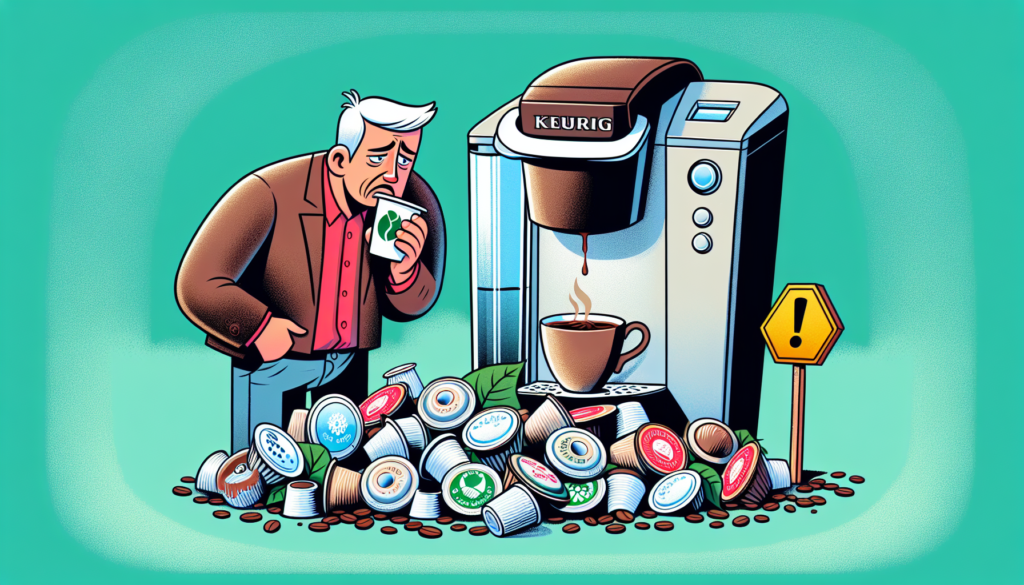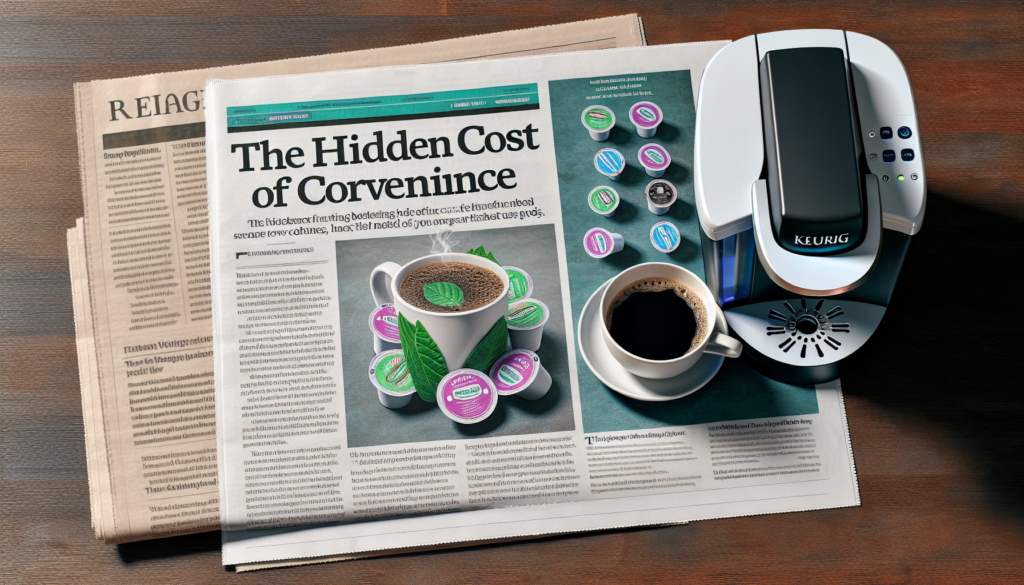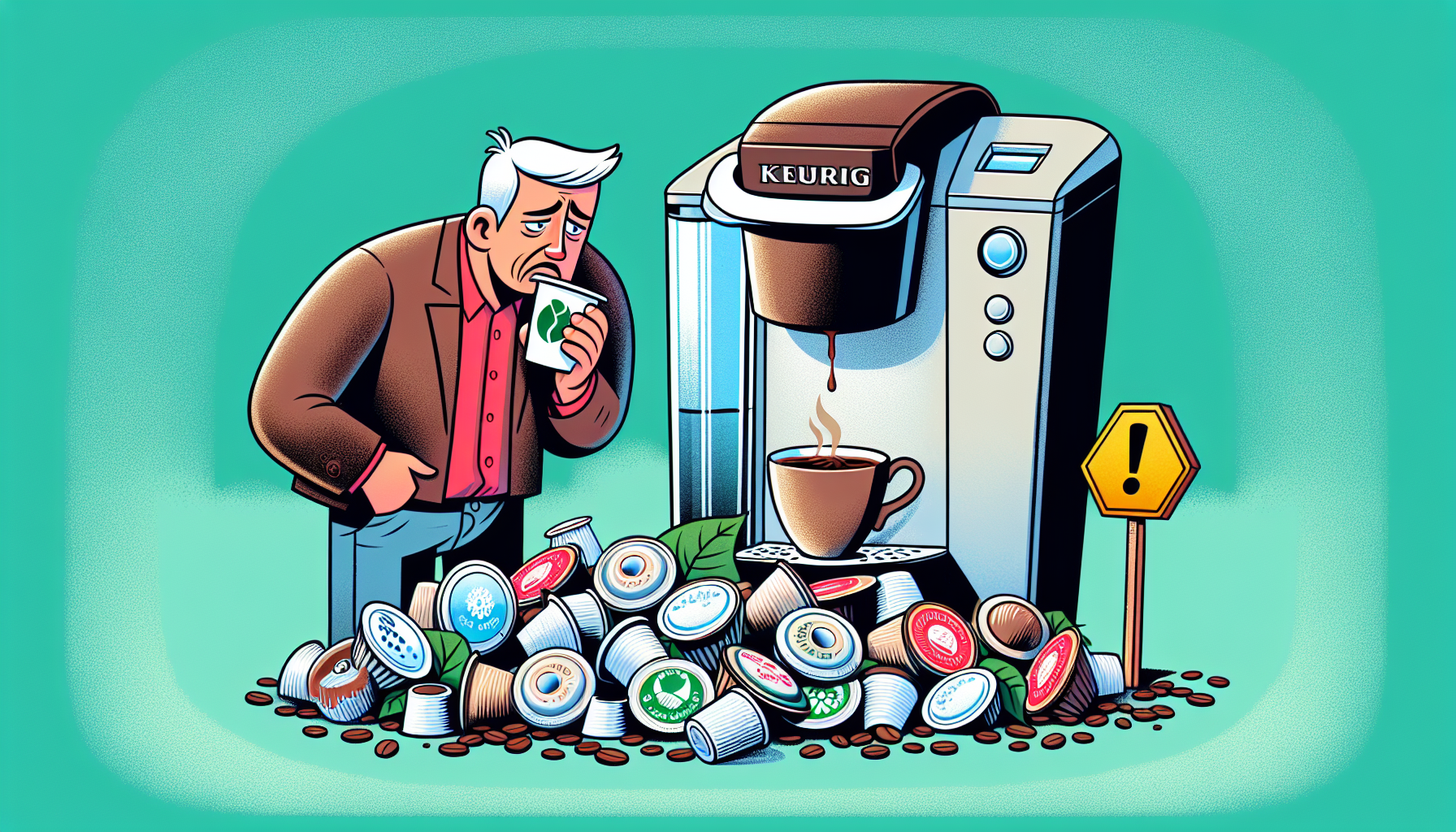You’ve probably seen the sleek and convenient Keurig coffee maker at your local café or even in your friend’s kitchen. With its promise of a quick and hassle-free cup of coffee, it may seem like an essential addition to your own morning routine. However, before you rush out to purchase one, it’s important to consider the potential downsides to using a Keurig. From environmental concerns to the quality of the coffee itself, there are compelling reasons to rethink this popular coffee machine.

CHECK OUT SINGLE SERVE BREWERS ON AMAZON
No Control over Coffee Quality
Limited Selection of Coffee
One of the major drawbacks of using a Keurig coffee maker is the limited selection of coffee available. While Keurig offers a wide range of options, including various flavors and roasts, you are restricted to the coffee that is specifically made for Keurig machines. This means that you may not be able to enjoy your favorite local or specialty coffee brands, and instead, you have to settle for the options provided by Keurig. This lack of variety can become monotonous and may not cater to the particular preferences of coffee enthusiasts.
Inconsistent Brewing Temperature
Another concern with Keurig coffee makers is the inconsistent brewing temperature. These machines are designed to brew coffee quickly by using hot water, but the temperature control may not always be accurate. This can result in coffee that is either too weak or too bitter, as the brewing temperature has a significant impact on the taste of the final cup. Without being able to control or adjust the brewing temperature, you may find it challenging to achieve the perfect balance and flavor in your coffee.
Lack of Freshness
When it comes to coffee, freshness is key to achieving a rich and flavorful cup. Unfortunately, Keurig coffee makers often fall short in this aspect. The pre-packaged pods used in these machines may have been sitting on shelves for months before reaching your kitchen, leading to a loss in aroma and taste. Coffee enthusiasts know that freshly ground beans and immediate brewing are essential for the best coffee experience. With a Keurig, you sacrifice the freshness factor and end up with a less-than-perfect cup of coffee.
Environmental Impact
Plastic Waste
One of the biggest environmental concerns associated with Keurig coffee makers is the amount of plastic waste they generate. Each time you use a single-serve pod, you are contributing to the ever-growing problem of plastic pollution. These plastic pods, although convenient, end up in landfills and take hundreds of years to decompose. This has a significant impact on our environment, especially considering the millions of Keurig users worldwide and the sheer number of pods being discarded on a daily basis.
Non-Recyclable Pods
Another environmental issue with Keurig coffee makers is the non-recyclable nature of the pods. The majority of single-serve coffee pods used in Keurig machines are made of a combination of materials, such as plastic and foil, which makes them virtually impossible to recycle. This means that every pod that is used ends up in the trash, contributing to the growing waste crisis. The lack of sustainable alternatives for these pods poses a challenge for environmentally conscious coffee drinkers who are looking to reduce their ecological footprint.
Carbon Footprint
In addition to plastic waste, Keurig coffee makers also have a significant carbon footprint. The production and distribution of these machines, as well as the transportation of the pre-packaged pods, require a vast amount of energy and resources. Furthermore, the machines themselves consume electricity, especially if they are left on standby mode for long periods. As environmental awareness grows, it is important to consider the impact of everyday choices, such as using a Keurig, on our planet’s health.
Higher Cost
Expensive Single-Serve Pods
Using a Keurig coffee maker can be costly in the long run, primarily due to the expense of single-serve pods. While the initial cost of the machine itself may seem reasonable, the ongoing requirement of purchasing pods adds up quickly. Individually, these pods often retail for a higher price compared to buying whole beans or ground coffee in larger quantities. For individuals or families who regularly consume multiple cups of coffee each day, the cost of using Keurig pods can become quite significant over time.
Inefficient for Multiple Cups
If you enjoy drinking more than one cup of coffee in a sitting or if you’re hosting guests, Keurig coffee makers can be quite inefficient. Each pod is designed to make a single serving, which means you have to go through the entire brewing process multiple times to satisfy everyone’s coffee needs. This not only takes more time and effort but also wastes additional energy. In this sense, Keurig machines may be better suited for individuals who only consume one cup of coffee at a time.
Additional Accessories and Maintenance Costs
Beyond the cost of the pods, using a Keurig may also require additional expenses for accessories and maintenance. For instance, if you prefer a specific type of coffee that is not available in Keurig pods, you may need a reusable pod or a separate accessory to make your own coffee. Moreover, Keurig machines have water filters that need to be replaced periodically, adding to the maintenance costs. When considering the overall expense of owning and using a Keurig, it is essential to factor in these additional costs.

CHECK OUT SINGLE SERVE BREWERS ON AMAZON
Health Concerns
Plastic Chemicals Leaching into Coffee
One of the health concerns associated with Keurig coffee makers is the potential for plastic chemicals to leach into the coffee during the brewing process. The single-serve pods used in Keurig machines are primarily made of plastic, which can release harmful substances when exposed to heat. While the actual health risks are still debated, some studies suggest that certain chemicals, such as BPA, may leach into the hot coffee. This can be worrisome for individuals who are particularly sensitive to plastic toxins or those who prioritize their overall well-being.
BPA in Water Reservoir
In addition to the plastic pods, Keurig machines often have plastic components, including the water reservoir, which may contain bisphenol A (BPA). BPA is a chemical compound commonly used in plastics that has been linked to potential health risks, including hormonal imbalances and reproductive issues. While Keurig claims that their machines are BPA-free, it is crucial to be aware of the potential hazards associated with plastic usage in general and make an informed decision based on individual health concerns.
High Sugar Content in Flavor Pods
Keurig offers a variety of flavored coffee pods for those who prefer a sweeter cup of coffee. However, many of these flavor pods contain high amounts of added sugars. Excessive sugar consumption has been linked to various health problems, including obesity, diabetes, and heart disease. While the occasional indulgence in a flavored coffee is not a major concern, relying on these artificially sweetened options can negatively impact your overall health and well-being. It is important to be mindful of the sugar content in the pods you choose and consider healthier alternatives when possible.
Less Customization
No Control over Coffee Strength or Size
One of the downsides of using a Keurig coffee maker is the limited control over the strength and size of your coffee. Keurig machines generally offer a few standard brewing options, such as small, medium, and large cup sizes, without the ability to customize the strength proportionally. This lack of control can be frustrating for individuals who prefer a specific coffee-to-water ratio to achieve their desired taste profile. If you enjoy experimenting with different brew strengths or prefer a stronger cup of coffee, a Keurig may not be the ideal choice for you.
Limited Options for Specialty Coffees
Keurig machines are primarily designed for convenience, which often means sacrificing the availability of specialty coffees. If you have a preference for unique and exotic coffee blends, such as single-origin or fair-trade options, you may find the selection limited when using a Keurig. The coffee pods available are typically mass-produced and aim for broad appeal, sometimes lacking the complexity and flavor nuances that specialty coffee enthusiasts seek. It is essential to consider your specific coffee preferences and whether a Keurig is aligned with them.
Inability to Adjust Brew Time or Temperature
When it comes to brewing coffee, time and temperature play a crucial role in the final taste and aroma. Unfortunately, Keurig coffee makers offer limited control over these variables. You cannot adjust the brew time or temperature to cater to your specific preferences. This lack of customization can hinder your ability to experiment with different brewing techniques or to fine-tune your coffee to perfection. If you are someone who enjoys the art and science of brewing, you may find the limitations of a Keurig restrictive and unsatisfying.
Dependence on Disposable Products
Single-Use Pods
One of the key criticisms of Keurig coffee makers is their reliance on single-use pods. Each cup of coffee requires a new pod, which, once used, becomes waste. This dependence on disposable products contributes to the throwaway culture that is detrimental to our environment. The convenience offered by Keurig machines comes at the expense of contributing to the growing plastic pollution crisis. As global awareness of environmental issues increases, many individuals are actively seeking ways to reduce their impact on the planet, making Keurig’s disposable pods less appealing in today’s world.
Paper Filters for Reusable Pods
While some Keurig users opt for reusable pods as a more sustainable alternative, these often require disposable paper filters. These filters add to the waste generated, as they need to be discarded after each use. While the use of reusable pods is a step towards reducing plastic waste, the dependence on paper filters still contributes to the overall environmental impact. Finding a balance between convenience and sustainability can be challenging, and for those concerned about minimizing waste, Keurig’s reliance on disposable products may be a significant drawback.
Indirect Support for Throwaway Culture
By using a Keurig coffee maker, you indirectly support a throwaway culture that is harmful to the environment. The popularity of single-serve pods has led to a significant increase in their production and consumption, resulting in vast amounts of waste. This throwaway mentality perpetuates our society’s wasteful habits, encouraging the mass production and consumption of non-recyclable products. As consumers, it is crucial to consider the long-term consequences of our choices and to seek alternatives that align with sustainable practices.
Lack of Brewing Techniques
No Option for Cold Brew or French Press
A notable limitation of Keurig coffee makers is the lack of versatility when it comes to brewing techniques. If you enjoy a wide range of coffee styles, such as cold brew or French press, a Keurig will not be able to fulfill your brewing needs. Keurig machines are designed specifically for hot brewing methods, which means you miss out on the unique flavors and textures that these alternative brewing techniques offer. If you crave diversity in your coffee experience and enjoy experimenting with different brew methods, a Keurig may not be the right choice.
Inability to Experiment with Different Brewing Methods
In addition to specific brewing techniques, Keurig coffee makers also limit your ability to experiment with various brewing methods. Keurig’s standardized approach to brewing means that each cup of coffee is brewed in the same manner, resulting in a homogenized taste across all cups. If you love the art of coffee brewing and enjoy exploring different extraction methods, such as pour-over or espresso, a Keurig’s lack of adaptability may leave you feeling unsatisfied. The inability to adjust brewing parameters can hinder your creativity and desire to perfect your brewing skills.
Homogenized Taste across All Cups
One of the downsides of Keurig coffee makers is the lack of variation in taste from one cup to another. While consistency can be desirable in some cases, coffee enthusiasts often appreciate the subtle differences in flavor and aroma that various brewing techniques and methods can provide. With a Keurig, each cup is brewed using the same pre-programmed settings, resulting in a homogenized taste experience. If you enjoy the nuances of coffee flavors and seek a unique experience in each cup, you may find Keurig’s lack of brewing techniques and customization disappointing.
Durability and Longevity
Plastic Construction Prone to Damage
Keurig coffee makers are predominantly made of plastic, which can make them more susceptible to damage over time. While plastic is lightweight and convenient, it is not as durable or long-lasting as other materials, such as stainless steel or ceramic. The reliance on plastic components in Keurig machines means that they are more prone to wear and tear, potentially leading to leaks, malfunctions, or a shorter lifespan compared to more robust coffee maker options. Considering the long-term investment and the desire for a reliable coffee machine, durability is an important factor to consider.
Limited Warranty and Costly Repairs
If your Keurig coffee maker does encounter issues or requires repairs, you may find yourself facing limited warranty coverage and costly repairs. Keurig’s warranties typically have a limited duration, and once the warranty period expires, any repairs needed can be quite expensive. This leaves users with the option of either incurring additional costs for repair services or replacing the entire machine. When considering the investment in a coffee maker, it is crucial to factor in the potential costs of repairs and the longevity of the machine.
Inconsistent Performance over Time
As with any appliance, Keurig coffee makers may experience a decline in performance over time. Users have reported issues such as slower brewing, inconsistent water flow, or a decline in overall brewing quality as the machines age. This can be frustrating for individuals who expect reliability and consistent performance from their coffee maker. While proper maintenance and care can help prolong the lifespan of a Keurig, the inevitable wear and tear associated with plastic components may affect the machine’s functionality and user experience over time.
Noise and Maintenance
Loud Brewing Process
One of the drawbacks of using a Keurig coffee maker is the noise generated during the brewing process. The pumps and heating elements used to brew the coffee can create a significant amount of noise, which can be disruptive, particularly in quiet environments or early mornings. If you live with others or in a shared space, the loud brewing process may be an inconvenience for both you and those around you. For individuals who value a quiet and peaceful coffee routine, the noise produced by a Keurig may be a significant drawback.
Frequent Descaling and Cleaning
To maintain optimal performance, Keurig coffee makers require regular cleaning and descaling. Over time, mineral deposits can build up inside the machine, affecting the taste and quality of your coffee. Descaling, which involves running a cleaning solution through the machine, needs to be done regularly to prevent clogs and ensure proper functionality. Additionally, the various components of the machine, such as the water reservoir and cup holder, need to be regularly cleaned to prevent mold or bacteria growth. The frequency of these cleaning tasks can be seen as a drawback for individuals seeking a hassle-free coffee experience.
Limited Lifespan of Water Filter
Keurig machines often come equipped with water filters to enhance the taste of the coffee by reducing impurities. However, these filters have a limited lifespan and need to be replaced periodically. The frequency of replacement depends on the water quality in your area and the amount of daily usage. While using a water filter can improve the taste of your coffee, the ongoing expense and effort of replacing it may be a deterrent for some users. It is essential to consider the maintenance requirements of a Keurig and how they align with your desired coffee routine.
Poor Taste and Aroma
Bland and Watered-Down Flavor
One of the most common criticisms of Keurig coffee makers is the perceived lack of flavor and overall quality of the coffee produced. Due to the rapid brewing process and standardized settings, some users find that the coffee tends to be bland and watered-down. This can be disappointing for coffee enthusiasts who prioritize a robust and flavorful cup of coffee. The convenience of a Keurig may come at the expense of taste, leaving individuals seeking a more enjoyable coffee experience feeling unsatisfied.
Inability to Adjust Extraction Parameters
Keurig coffee makers offer limited control over the various extraction parameters that contribute to the taste and aroma of coffee. Unlike manual brewing methods, where you can adjust variables such as water temperature, brew time, or grind size, Keurig machines have pre-set settings that cannot be fine-tuned. Without the ability to customize these extraction parameters, you are left with a coffee that may not meet your specific taste preferences. If you enjoy experimenting with different brewing techniques or extracting the optimal flavors from your coffee beans, a Keurig may not provide the desired level of control.
Lack of Freshly Ground Beans
Freshly ground coffee beans are a fundamental aspect of a flavorful cup of coffee. However, using a Keurig means sacrificing the freshness associated with whole bean coffee. Keurig pods are filled with pre-ground coffee, which may have been sitting packaged on shelves for months before reaching your machine. This long shelf life can result in a loss of flavor and aroma. For those who appreciate the unique characteristics that freshly ground beans bring to a cup of coffee, the lack of availability of this option can be a significant drawback of using a Keurig.

